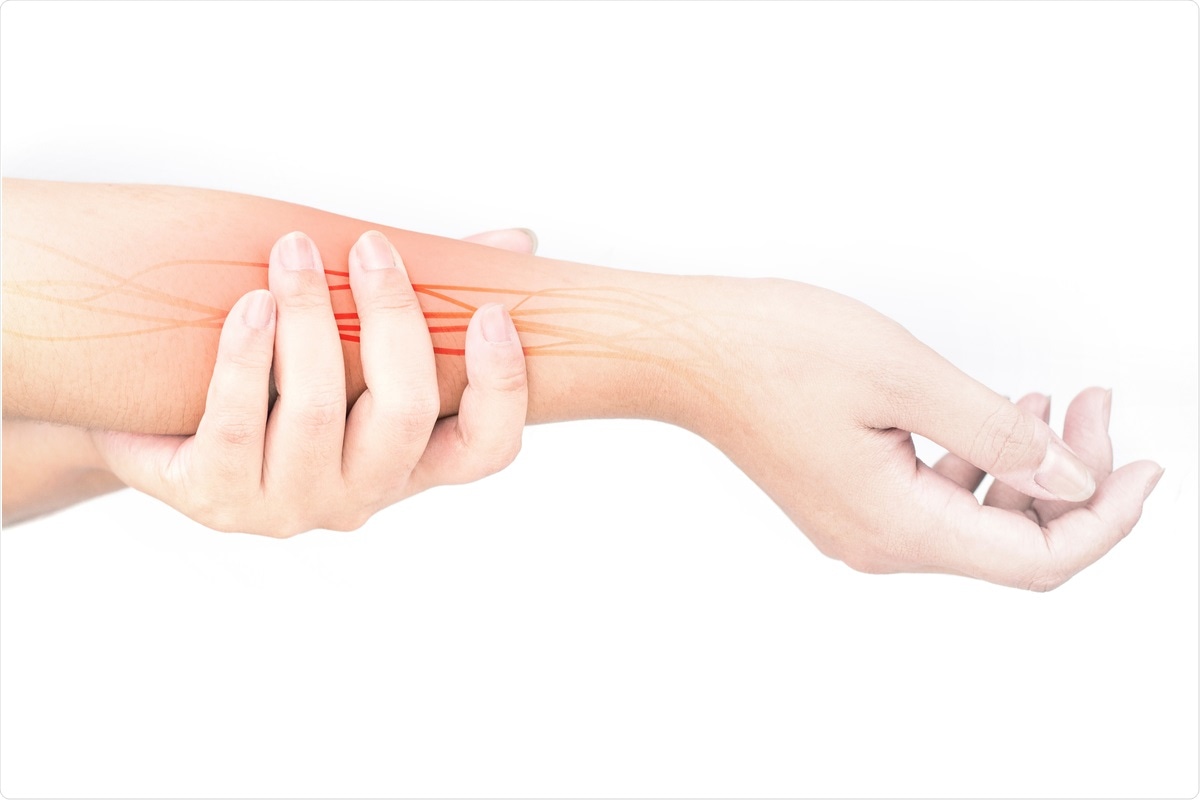The coronavirus disease 2019 (COVID-19) pandemic has led to the recognition of possible long-term and unexpected complications, whether caused directly by infection with severe acute respiratory syndrome coronavirus 2 (SARS-CoV-2) or not. An interesting new study discusses the occurrence of peripheral nerve injuries in a subset of patients who survived severe COVID-19.
 Study: Acquired peripheral nerve injuries associated with severe COVID-19. Image Credit: SoftSheep/ Shutterstock
Study: Acquired peripheral nerve injuries associated with severe COVID-19. Image Credit: SoftSheep/ Shutterstock
A preprint version of the study is available on the medRxiv* server while the article undergoes peer review.
Background
Individuals who contract severe COVID-19 often require admission to the intensive care unit (ICU) and may be put on mechanical ventilation for long periods. Earlier studies on such patients have pointed out a phenomenon called ICU acquired weakness (ICU-AW). This refers to a neuromuscular complication of severe COVID-19, occurring as part of the serious complications reported in this condition.
Three clinical presentations have been described so far. The first is myopathy of critical illness; the second is polyneuropathy related to critical illness; the third combines both, also termed critical illness neuromyopathy. However, ICU-AW typically causes generalized and symmetric symptoms.
In contrast, unilateral or localized neuromuscular symptoms should lead to a suspicion of peripheral nerve injuries (PNIs). These may occur alongside ICU-AW but are often unnoticed because of the constant need for acute care unless a neuromuscular assessment is carefully performed.
The early case reports and case series of PNIs in patients recovering from severe COVID-19, and undergoing inpatient rehabilitation, have led to the recognition of this condition. Importantly, such PNIs seem to be due to compression or traction injuries, occurring as they do in sites vulnerable to mechanical forces.
The outcome after a PNI is often unsatisfactory in the general population. This risk is likely exacerbated in the severe COVID-19 survivor group, who often have risk factors such as diabetes, obesity, and age. This means that these individuals may have to live with such PNIs, leading to chronic disability in as many as 16% of them.
What did the study show?
The researchers used a retrospective design to examine patient charts in this category of COVID-19 patients while also testing the utility of a wearable pressure sensor at the elbow to provide real-time monitoring of nerve pressure at this most commonly affected site.
The study included 32 patients who survived severe COVID-19 and had PNIs. Most were male, with a mean age of 53 years and an average body mass index (BMI) of 33. Underlying conditions like diabetes and obesity were present in half and 60% of the group, respectively.
There were 63 PNIs, at 11 sites, including the common fibular nerve in 16 cases, the ulnar in 10, the sciatic in nine, and the radial and median nerve in six cases each. In over half the patients, or 17/32, multiple PNIs were observed.
Further testing records for 55/63 PNIs indicate that the nerve was injured severely in the vast majority, or 93%, by axonotmesis, compared to neuropraxia in the rest.
Combining with earlier case series, the researchers found 169 reports of PNIs over 16 sites in 81 patients. Overall, the most commonly injured site was the ulnar nerve in 26%, followed by the common fibular nerve in 16%, the median and sciatic nerve in 11%, the brachial plexus in 10%, and the radial nerve in 8%. The distribution thus follows a slightly different pattern, but the ulnar and common fibular nerves are always at the most risk for PNIs.
Many patients had pressure sores over bony sites like the fibular head and the elbow, which led to the exploration of the feasibility of a wireless, soft, skin-interfaced pressure sensor to detect high-risk mechanical forces in such cases. Simple interventions such as placing a cushion under an elbow can result in high pressures on the nerve at such points.
What are the implications?
The unexpectedly high incidence of PNIs in survivors of severe COVID-19 means that these can cause chronic nerve damage in this group of patients. Mechanical forces such as compression are likely to be responsible for these injuries. Hematoma formation, or central line placement, may cause the occasional PNI as well.
Underlying conditions like obesity and diabetes mellitus may worsen the risk via increased chances of neuropathy against a background of inflammation and immune-mediated injury in patients with severe COVID-19. Direct injury by the virus needs to be explored, as data is lacking in this regard.
A wearable pressure sensor could help prevent PNIs in these patients by providing real-time data on nerve compression at the elbow, seen to be the site at greatest risk of compressive nerve injury in severe COVID-19. With prone positioning, for example, often adopted for 12-16 hours a day in adults on mechanical ventilation to treat severe hypoxemia in COVID-19, PNIs are especially likely.
*Important notice
medRxiv publishes preliminary scientific reports that are not peer-reviewed and, therefore, should not be regarded as conclusive, guide clinical practice/health-related behavior, or treated as established information.
- Franz, C. K. et al. (2021). Acquired Peripheral Nerve Injuries Associated with Severe COVID-19. medRxiv preprint. doi: https://doi.org/10.1101/2021.09.24.21263996. https://www.medrxiv.org/content/10.1101/2021.09.24.21263996v1
Posted in: Medical Science News | Medical Research News | Disease/Infection News
Tags: Body Mass Index, Brachial Plexus, Chronic, Coronavirus, Coronavirus Disease COVID-19, Diabetes, Diabetes Mellitus, Disability, Hypoxemia, Inflammation, Intensive Care, Myopathy, Nerve, Neuropathy, Obesity, Pandemic, Respiratory, SARS, SARS-CoV-2, Severe Acute Respiratory, Severe Acute Respiratory Syndrome, Skin, Syndrome, Traction, Ulnar Nerve, Virus

Written by
Dr. Liji Thomas
Dr. Liji Thomas is an OB-GYN, who graduated from the Government Medical College, University of Calicut, Kerala, in 2001. Liji practiced as a full-time consultant in obstetrics/gynecology in a private hospital for a few years following her graduation. She has counseled hundreds of patients facing issues from pregnancy-related problems and infertility, and has been in charge of over 2,000 deliveries, striving always to achieve a normal delivery rather than operative.
Source: Read Full Article
